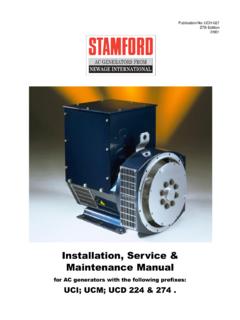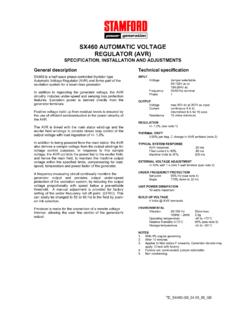Transcription of MX321 AUTOMATIC VOLTAGE REGULATOR (AVR)
1 MX321 AUTOMATIC VOLTAGE REGULATOR (AVR) SPECIFICATION, INSTALLATION AND ADJUSTMENTS General description Technical specification MX321 is a three phase sensed AUTOMATIC VOLTAGE REGULATOR and forms part of the excitation system for a brush-less generator. Excitation power is derived from a three-phase permanent magnet generator (PMG), to isolate the AVR control circuits from the effects of non-linear loads and to reduce radio frequency interference on the generator terminals. Sustained generator short circuit current is another feature of the PMG system. The AVR senses the VOLTAGE in the main generator winding and controls the excitation to maintain the generator output VOLTAGE within the specified limits, compensating for load, speed, temperature and power factor of the generator.
2 Three phase RMS sensing is employed for superior VOLTAGE regulation. Adjustable Soft start circuitry is included to provide a smooth controlled build up of generator output VOLTAGE . A frequency measuring circuit continually monitors the shaft speed of the generator and provides under-speed protection of the excitation system by reducing the generator output VOLTAGE proportionally with speed below a pre-settable threshold. A further enhancement of this feature is an adjustable volts per Hertz slope and VOLTAGE recovery time, to improve the response of turbo charged engines. Current limiting may be included to allow control over the amount of sustained short circuit current. Maximum excitation is limited to a safe period by internal shutdown of the AVR output device.
3 This condition remains latched until the generator has stopped. The AVR includes an over- VOLTAGE protection feature with internal shutdown of the AVR output device, plus the ability to trip an optional excitation circuit breaker if required. Provision is made for the connection of a remote VOLTAGE trimmer, allowing the user fine control of the generator's output. An analogue input is provided allowing connection to a Newage Power Factor controller or other external device with compatible output. The AVR has the facility for droop CT connection, to allow parallel running with other similarly equipped generators. SENSING INPUT VOLTAGE 190-264V ac max, 2 or 3 phase Frequency 50-60 Hz nominal POWER INPUT (PMG) VOLTAGE 170-220V ac max, 3 phase, 3 wire Current 3A/phase Frequency 100-120 Hz nominal OUTPUT VOLTAGE max 120V dc Current continuous A (see note 1) Intermittent 6A for 10 secs.
4 Resistance 15 ohms minimum REGULATION +/- RMS with 4% engine governing (see note 2) THERMAL DRIFT per deg. C change in AVR ambient (note 3) SOFT START RAMP TIME - 4 seconds TYPICAL SYSTEM RESPONSE AVR response 10 ms Filed current to 90% 80 ms Machine Volts to 97% 300 ms EXTERNAL VOLTAGE ADJUSTMENT +/-10% with 5 k ohm 1 watt trimmer (see note 4) UNDER FREQUENCY PROTECTION Set point 95% Hz (see note 5) Slope 100-300% down to 30 Hz Max. Dwell 20% volts/S recovery UNIT POWER DISSIPATION 18 watts maximum ANALOGUE INPUT Maximum input +/- 5 Vdc (see note 6) Sensitivity 1v for 5% Generator Volts (adjustable) Input resistance 1k ohm QUADRATURE DROOP INPUT 10 ohms burden Max. sensitivity: A for 5% droop 0PF Max.
5 Input: A CURRENT LIMIT INPUT 10 ohms burden Sensitivity range: 1A OVER VOLTAGE DETECTOR INPUT Set point: 300v. Time delay: 1 Sec (fixed) CB trip coil volts: 10-30 vdc CB trip coil resistance: 20-60 ohms OVER EXCITATION PROTECTION Set point 75 V dc Time delay 8-15 seconds (fixed) ENVIRONMENTAL Vibration 20-100 Hz 50mm/sec 100Hz 2kHz Operating temperature -40 to +700C Relative Humidity 0-700C 95% (see note 7) Storage temperature -55 to +800C NOTES 1. Derate linearly from at 50 C to at 70 C 2. The stated VOLTAGE regulation may not be maintained in the presence of certain transmitted radio signals. Any change in regulation will fall within the limits in Criteria B of : 2001.
6 3. After 10 minutes. 4. Applies to Mod status E onwards. Generator de-rate may apply. Check with set, semi-sealed, jumper selectable. 5. Any device connected to the analogue input must be fully floating (galvanically isolated from ground), with an insulation strength of 500V ac. 6. Non condensing. DESIGN DETAIL The main functions of the AVR are: Potential Divider and Rectifier takes a proportion of the generator output VOLTAGE and attenuates it. The potential divider is adjustable by the AVR Volts potentiometer and external hand trimmer (when fitted). The output from the droop CT is also added to this signal. A rectifier converts the input signal into a signal representing generator VOLTAGE .
7 The DC Mixer adds the Analogue input signal the generator VOLTAGE signal. The 3 Phase Rectifier converts the output of the current limit CT s into a dc signal representing generator current. The Amplifier (Amp) compares the generator VOLTAGE or current signals to the Reference VOLTAGE and amplifies the difference (error) to provide a controlling signal for the power devices. The Ramp Generator and Level Detector and Driver infinitely control the conduction period of the Power Control Devices and hence provides the excitation system with the required power to maintain the generator VOLTAGE within specified limits. The Stability Circuit provides adjustable negative ac feedback to ensure good steady state and transient performance of the control system.
8 The Power Supply provides the required voltages for the AVR circuitry. The Low Hz Detector measures the period of each electrical cycle and causes the reference VOLTAGE to be reduced approximately linearly with speed below a presettable threshold. The Dip and Dwell circuits provide adjustments for greater VOLTAGE roll off and recovery time. A Light Emitting Diode gives indication of underspeed running. The Synchronising circuit is used to keep the Ramp Generator and Low Hz Detector locked to the Permanent Magnet Generator waveform period. Power Control Devices vary the amount of exciter field current in response to the error signal produced by the Amplifier. The Circuit Breaker provides circuit isolation of the control system in the event of an over excitation or over VOLTAGE condition.
9 The Over Excitation Detector continuously monitors the exciter field VOLTAGE and turns off the power device if this rises above the reference leve,l for greater than the stated time period. An external signal is also provided to trip the Circuit Breaker The Over VOLTAGE Detector continuously monitors the generator stator VOLTAGE and turns off the power device if this rises above the reference level, for greater than the stated time period. An external signal is also provided to trip the Circuit Breaker SynchronisingCircuit Low Hz Detection Dip & Dwell Power Control Devices Level Detector & Driver Reference VoltageStability CircuitPotential Divider & Rectifier Power supplyRamp GeneratorPMG AmpStator VOLTAGE Sensing Hand Trimmer Exciter Field DC Mixer Analogue Input Droop Over Excitation Detector 3 Phase Rectifier Current Limit Input Over - VOLTAGE Detector Circuit BreakerOver VOLTAGE Sensing FITTING AND OPERATING (Refer to generator wiring diagram for connection details)
10 SUMMARY OF AVR CONTROLS CONTROL FUNCTION DIRECTION VOLTS TO ADJUST GENERATOR OUTPUT VOLTAGE CLOCKWISE INCREASES OUTPUT VOLTAGE STABILITY TO PREVENT VOLTAGE HUNTING CLOCKWISE INCREASE THE DAMPING EFFECT UFRO TO SET THE UFRO KNEE POINT CLOCKWISE REDUCES THE KNEE POINT FREQUENCY DROOP TO SET THE GENERATOR DROOP TO 5% AT 0PF CLOCKWISE INCREASES THE DROOP TRIM TO OPTIMISE ANALOGUE INPUT SENSITIVITY CLOCKWISE INCREASES THE GAIN OR SENSITIVITY EXC TO SET THE OVER EXCITATION TRIP LEVEL CLOCKWISE INCREASES THE TRIP LEVEL DIP TO SET THE HZ RELATED VOLTAGE DIP CLOCKWISE INCREASES THE DIP DWELL TO SET THE HZ RELATED RECOVERY TIME CLOCKWISE INCREASES THE RECOVERY TIME I LIMIT TO SET THE STATOR CURRENT LIMIT CLOCKWISE INCREASES THE CURENT LIMIT OVER V TO SET THE OVER VOLTAGE TRIP LEVEL CLOCKWISE INCREASES THE TRIP LEVEL RAMP TO SET THE NO LOAD VOLTAGE RAMP UP TIME CLOCKWISE INCREASES THE VOLTAGE RAMP TIME ADJUSTMENT OF AVR CONTROLS VOLTAGE ADJUSTMENT The generator output VOLTAGE is set at the factory, but can be altered by careful adjustment of the VOLTS control on the AVR board, or by the external hand trimmer if fitted.




